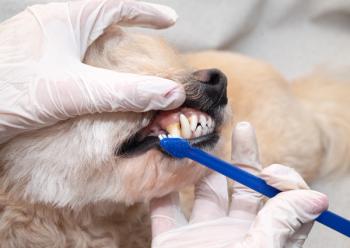
Treating Hydrated Nucleus Pulposus Extrusion in Dogs
Which treatment method has higher success rates and shorter recovery times: surgical or conservative management?
Hydrated nucleus pulposus extrusion (HNPE) is a recently described pattern of intervertebral disk herniation in dogs. HNPE differs from other forms of compressive myelopathy, as the extruded disk material is gelatinous or liquid rather than solid or calcified.
Most HNPE studies emphasize surgical rather than conservative management. However, researchers in Germany
Evaluation of 36 HNPE Cases
Thirty-six dogs were diagnosed with HNPE at the University of Veterinary Medicine in Hanover between 2006 and 2017. Magnetic resonance imaging (MRI) indicated extradural spinal cord compression caused by well-delineated T2-weighted hyperintense and T1-weighted isointense or hypointense material originating from the intervertebral disk space in a “seagull” shape.
Mobility at presentation was as follows:
- 1 ambulatory and 2 nonambulatory paraparetic dogs
- 4 ambulatory and 22 nonambulatory tetraparetic dogs
- 7 tetraplegic dogs with intact nociception
Ten dogs had spinal hyperesthesia, and urinary retention was noted in 5 dogs. Lesions were localized to the cervical region in 33 dogs and to the thoracolumbar junction in 3 dogs, and maximal cross-sectional spinal cord compression ranged from 0% to 62%. Seventeen pure breeds and several mixed breeds were represented.
Half of the dogs underwent surgery, which consisted of a ventral slot for cervical HNPE or a hemilaminectomy for thoracolumbar HNPE. Surgery was most frequently chosen for those dogs with heterogeneous-appearing extruded disk material on MRI. Postoperative care or conservative management for nonsurgical cases consisted of cage rest, physiotherapy, and multimodal analgesic therapy including metamizole, either gabapentin or pregabalin, constant-rate infusion of fentanyl-lidocaine-ketamine, and bethanechol and phenoxybenzamine as needed for urinary retention.
Treatment and Outcome
Sixteen of 18 surgically managed dogs and 17 of 18 conservatively managed dogs achieved functional recovery, while 3 dogs died due to either cardiopulmonary arrest or ascending-descending myelomalacia. Functional recovery was achieved within a median of 6 to 7 days for both treatment groups, and only 1 dog took more than 15 days to recover. Those dogs that either died or required a longer recovery time had significantly larger lesions compared with dogs that recovered quickly, regardless of the treatment chosen.
Outcome was not significantly affected by any of the following factors:
- Age, sex, or weight
- Severity or duration of neurologic signs or spinal hyperesthesia
- HNPE localization
- Severity of spinal cord compression
- Signal intensity of extruded disk material
Summary
This study, the first to compare surgical and conservative management of HNPE, revealed that both treatments had similar success rates. The authors hypothesized that the gelatinous or liquid consistency of extruded disk material in HNPE allows it to disperse within the vertebral canal, alleviating spinal compression even without surgical intervention. They did note that surgery was chosen most frequently when MRI indicated the presence of heterogeneous (relatively firm) disk material, implying that long-term spinal cord compression was likely without surgical removal.
Dr. Stilwell received her DVM from Auburn University, followed by a MS in fisheries and aquatic sciences and a PhD in veterinary medical sciences from the University of Florida. She provides freelance medical writing and aquatic veterinary consulting services through her business,
Newsletter
From exam room tips to practice management insights, get trusted veterinary news delivered straight to your inbox—subscribe to dvm360.






